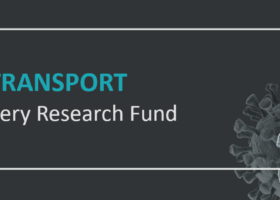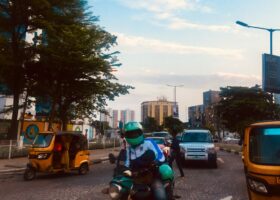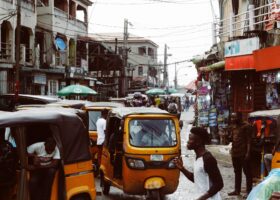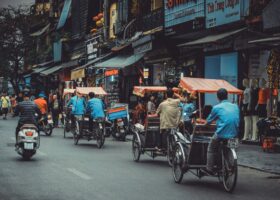Overview
Urban transport networks have historically been designed around journeys to work in the formal sector – traditionally considered the primary trip purpose. However, it has been well-documented that although this tends to serve the male population well, women’s journeys are often to informal employment, more complex, with multiple destinations or by being accompanied by children or baggage.
COVID-19 has created a need to rapidly review and re-plan public transport networks in order to differently serve the most dominant journeys. As such, this project has sought to answer the core question, ‘How can urban transport networks be rapidly reviewed, redesigned and rolled out for a more gender-equitable system?’
The impacts of COVID-19 and associated reduction in transport services have created several shifts in this paradigm:
• Firstly, many workers are no longer making their single-leg trips to work, reducing the dominance of these trips in line with the reduction in service. Meanwhile women’s typically undervalued trips (accessing markets, health centres, unpaid caring roles etc.) continue, as they remain vital to the functioning of their communities.
• Secondly, due to the irreplaceable nature of these trips, the impact of reductions in transport services through 2020 will have disproportionately impacted women’s ability to support their families.
• Finally, looking forward past COVID-19, the need to enable and invest in local trips has particular relevance for women’s journeys.
The primary objective of this user guide is to provide best practice techniques that can be rapidly applied in designing equitable networks during and following the COVID-19 crisis. The guidance will also be applicable to any urban area seeking to re-design their transport network without the means to undertake a full (traditional) study.
To help guide the understanding of the methodologies and tools being discussed we will be using the city of Mandalay, Myanmar, as a pilot study. This location has been chosen for the following reasons:
• Myanmar is a LIC.
• Mandalay City has a population of around 1.2 million people with a relatively simple network of formal public transport, from experience we hav
Publications with the same themes
Publications with the same study countries
Related news & events
News
News
News
News
Blog
News
Blog
Blog
PDF content (text-only)
COVID-19 Response & Recovery Transport Research Fund USER GUIDE: Best practice on designing for equitable public transport networks through accessibility modelling January 2021 HVT029.L1S150 – Integrated Transport Planning Ltd i This research was funded by UKAID through the UK Foreign, Commonwealth & Development Office under the High Volume Transport Applied Research Programme, managed by IMC Worldwide. The views expressed in this report are those of the authors and do not necessarily reflect the UK government's official policies, nor those of any individuals and organisations referred to in this report. IMC Worldwide Ltd, the HVT Programme and the UK government shall not assume any responsibility for the results of works based on the use of this report. Users accept this publication is a guidance document only. Users accept that they need to take their own technical and legal advice before issuing Agreements, Terms and Conditions and other legally binding documentation related to implementing any recommendations. Reference No. HVT029.L1S150 Lead Organisation/ Consultant Integrated Transport Planning (ITP) Partner Organisation(s)/ Consultant(s) N/A Title Best practice on designing for equitable public transport networks through accessibility modelling in emerging COVID-19 cities Type of document Project Report Theme Gender, inclusion, vulnerable groups Sub-theme Urban transport Author(s) Ian Stott, Ruby Stringer Lead contact Ian Stott Geographical Location(s) Myanmar ii USER GUIDE: Best practice on designing for equitable public transport networks through accessibility modelling CONTENTS 1. Introduction 1 2. Background 2 3. Accessibility modelling 6 4. Open data/ resources 7 4.1 Mapping data 7 4.2 Population data 8 4.3 Public transport data 8 4.4 Mapping tools (GIS) 8 4.5 Accessibility modelling tools 9 4.6 Web links 9 5. Methodology and pilot example 10 5.1 Pilot city example: Mandalay, Myanmar 11 5.1.1 Population data (origins) 12 5.1.2 Destination data 12 5.1.3 Road network data 12 5.1.4 Public transport data 13 5.1.5 GIS model: access to the transport network 14 5.1.6 Accessibility model: access through the transport network 15 5.1.7 Analysing results to improve the network 16 6. Conclusion 18 7. Hyperlinks 18 TABLES Table 1: Population by travel time 16 FIGURES Figure 1: Illustration of a "normal day" for a woman from Western Europe 3 Figure 2: Gender modal split in Hanover (2009) 4 Figure 3: OpenStreetMap website 7 Figure 4: Geofabrik website 7 Figure 5: Worldpop website 8 Figure 6: QGIS website 9 Figure 7: Flowchart 1 - Traditional method of transport network planning 10 Figure 8: Flowchart 2 - Proposed method of transport network planning 11 Figure 9: Flowchart 3 – Pilot city methodology 11 Figure 10: Mandalay population density 12 Figure 11: Mandalay OSM road network and local centres 13 Figure 12: Mandalay GTFS network stops 14 Figure 13: Access to public transport stops 15 Figure 14: 60-minute access to local centres 16 iii USER GUIDE: Best practice on designing for equitable public transport networks through accessibility modelling ACRONYMS ADB Asian Development Bank CBD Central Business District COVID-19 Novel Coronavirus 2019 FCDO Foreign, Commonwealth & Development Office GIS Geographic Information System GTFS General Transit Feed Specification HVT High Volume Transport Applied Research Programme IMC IMC Worldwide Ltd ITDP Institute for Transportation and Development Policy ITP Integrated Transport Planning LIC Low-income country NGO Non-Government Organisation OD Origin Destination OSM OpenStreetMap UK United Kingdom iv USER GUIDE: Best practice on designing for equitable public transport networks through accessibility modelling FOREWORD ITP are a sustainable transport planning consultancy based in the UK. Our primary goal is to 'improve the way the world moves'. We have been working in Low-Income Countries (LICs) throughout our 22-year history, working across Africa, Asia, Latin America, Oceania and Europe. For the past 10 years we have been working with open data and open tools, helping promote the benefits they can have for areas without the wealth to pay for such services. We are also strong believers in the benefits accessibility modelling (travel time modelling) can have in helping assist authorities understand their networks, and that transport networks should be for all people. www.itpworld.net @itptweet The High Volume Transport Applied Research Programme (HVT) is a five-year programme funded by the Foreign, Commonwealth & Development Office (FCDO). The objective of the programme is to strengthen the evidence base that will support high-volume road and rail transport in Low-Income Countries to be greener, more accessible, more affordable, more inclusive and safer. www.hvt.preview.consideredcreative.com @transport_links This project responds to the Call for Action by the HVT programme published in April 2020. The Call for Action invited collaboration from the international community to strengthen advice to help transport decision makers within LICs respond to the impact of the COVID-19 pandemic. There are other HVT documents of relevance to this project, including the 'COVID-19 Urban Transport Response: Opportunities for Policy-making in Africa' published in May 2020. We would like to thank Tara San, Independent consultant based in Myanmar, for helping with the local context for the pilot study We would also like to thank the following people for providing expert insight through interviews on the guidance: • Heather Allen – International Gender Expert; • Fatima Arroyo Arroyo – Task Team Leader at The World Bank; • Professor Gina Porter – Senior Research Fellow in the Department of Anthropology, University of Durham; • Jeff Turner – International Gender Expert; and • Professor Mark Zuidgeest – Professor in the Department of Civil Engineering, University of Cape Town. 1 USER GUIDE: Best practice on designing for equitable public transport networks through accessibility modelling 1. Introduction Urban transport networks have historically been designed around journeys to work in the formal sector – traditionally considered the primary trip purpose. However, it has been well-documented that although this tends to serve the male population well, women's journeys are often to informal employment, more complex, with multiple destinations or by being accompanied by children or baggage. COVID-19 has created a need to rapidly review and re-plan public transport networks in order to differently serve the most dominant journeys. As such, this project has sought to answer the core question, 'How can urban transport networks be rapidly reviewed, redesigned and rolled out for a more gender-equitable system?' The impacts of COVID-19 and associated reduction in transport services have created several shifts in this paradigm: • Firstly, many workers are no longer making their single-leg trips to work, reducing the dominance of these trips in line with the reduction in service. Meanwhile women's typically undervalued trips (accessing markets, health centres, unpaid caring roles etc.) continue, as they remain vital to the functioning of their communities. • Secondly, due to the irreplaceable nature of these trips, the impact of reductions in transport services through 2020 will have disproportionately impacted women's ability to support their families. • Finally, looking forward past COVID-19, the need to enable and invest in local trips has particular relevance for women's journeys. The primary objective of this user guide is to provide best practice techniques that can be rapidly applied in designing equitable networks during and following the COVID-19 crisis. The guidance will also be applicable to any urban area seeking to re-design their transport network without the means to undertake a full (traditional) study. To help guide the understanding of the methodologies and tools being discussed we will be using the city of Mandalay, Myanmar, as a pilot study. This location has been chosen for the following reasons: • Myanmar is a LIC. • Mandalay City has a population of around 1.2 million people with a relatively simple network of formal public transport, from experience we have found that cities of this size or smaller are ideal for the methodologies described in this paper. Limitations of the approach It should be noted that in larger cities, where formal transport networks are more established or interactions between modes are more complex, a larger traditional transport model would likely still be required. Furthermore, the proposed approach using accessibility modelling must be used in conjunction with an appreciation of the local context, which should be collected in an equitable manner to avoid the exclusion of certain groups of travellers, whether that is in relation to gender, income or other characteristics. The proposed approach should not be used in isolation of this further level of detail. 2 USER GUIDE: Best practice on designing for equitable public transport networks through accessibility modelling 2. Background Network Planning Methods Traditional public transport network planning dictates that a model must be built in order to plan a new transport route or system, allowing the reallocation of existing Origin-Destination (OD) data onto a modelled public transport system. For example, with reference to planning a new BRT, Institute for Transportation and Development Policy (ITDP) recommends the use of modelling packages such as Emme, Cube and Visum. ITDP also mentions, though, that "All of these are expensive packages. However, in actuality, the most significant costs will be training staff to become familiar and adept with the software package." 1 . Not only are these models expensive, but the reliance on OD pairs in a modelling context often leads to a prioritisation of certain trips due to the availability of data. In the past two decades, authors have increasingly recognised that public transport operates most successfully when planned as a unified network, rather than individual lines catering to single trips2 . This is particularly important in relation to the data that is used for planning networks. In the UK for example, Census data is collected on Journey-to-work data, creating OD pairs that can be adapted for use in a model. There is no equivalent alternative for non-work journeys, which happen to be more relevant for female travellers (this is explored in more detail in the following chapter). "Algorithmic bias doesn't start with the algorithms, it starts with the bias. That bias comes in two basic forms, one more active and one more passive; one about what is present and one what is absent. Both forms matter and often both come together." 3 As this quote suggests, detailed OD data which reflects travel demand for the entire population is uncommon, and particularly uncommon in low-income countries. By investigating all possible journeys and taking a network planning approach, the impact of this bias can be reduced. Gender and transport There are well-documented differences between men's and women's journeys. Men are more likely to do simple, linear journeys between home and workplace, whereas women are more likely to trip-chain. This is largely due to their higher proportion of household and reproductive responsibilities. The diagram below demonstrates this difference in relation to differences seen between genders in Western Europe.4 1 ITDP (2020) 4.4 Estimating Demand with a Public Transport Model https://brtguide.itdp.org/branch/master/guide/demandanalysis/estimating-demand-with-a-public-transport-model 2 Dodson, J; Mees, P; Stone, J; Burke, M (2011) The Principles of Public Transport Network Planning: A review of the emerging literature with select examples, Griffith University Urban Research Program 3 Nicole Badstuber (2019) Mind the Gender Gap: The Hidden Data Gap in Transport, https://www.strategicreading.uk/2019/04/mindthe-gender-gap-the-hidden-data-gap-in-transport/ 4 CIVITAS (2020) Gender equality and mobility: mind the gap! 3 USER GUIDE: Best practice on designing for equitable public transport networks through accessibility modelling Figure 1: Illustration of a "normal day" for a woman from Western Europe IMAGE SOURCE4 However, this also holds true for low-income countries, where women's journeys are consistently found to be multi-purpose and complex. In the global South, women's journeys are more likely to be constrained by cost – reducing accessibility to health, education and employment opportunities.5 Unsurprisingly due to this, women's travel habits are more dramatically influenced by life events and their reproductive timeline4 , for example, with women's journeys being heavily impacted by being pregnant or the presence of children. One study on the use of informal motorcycle taxis (okadas) in Nigeria showed that whilst 83% of men were single passengers, only 8% of women were – mainly due to being accompanied by children and toddlers. The same study found this to have grave safety impacts, with a significantly higher number of female than male passengers involved in three or more accidents per year, with particularly dire consequences for children.6 Again, there are differences between male and female public transport use depending on the country. In developed countries, women tend to make up the majority of public transport users as men are more likely to be able to drive and to take control of the household car for travelling to work. This is reflected in figure 2 below regarding gender modal split in Hanover (2009), showing that car-as-a-driver is significantly lower for women than men across the board. 5 Uteng, T P (2019) State of the Knowledge Study on GENDER AND TRANSPORT in DEVELOPING ECONOMIES, HVT 6 Peters, D (2013) Gender and Sustainable Urban Mobility, UNHABITAT 4 USER GUIDE: Best practice on designing for equitable public transport networks through accessibility modelling Figure 2: Gender modal split in Hanover (2009) IMAGE SOURCE5 In developing countries formal public transport is often among the more expensive mode choices available to households, forcing low-income women in particular to revert to even cheaper modes, often provided by informal operators. A major finding in a social assessment for an urban transport project in Ashgabat, Turkmenistan, where women had 30 per cent lower earnings than men, was that women relied more heavily on cheaper and less reliable buses and trolleys, whereas men had comparatively better access to minibuses, taxis or enterprise transport. 5 Furthermore, a feature of transport networks designed largely by men has been a consistent focus on improving point-to-point connectivity (i.e. to the Central Business District), but less concentration on the development of a fully integrated network which better suits the complex travel needs of female travellers. For these types of multi-purpose trips, market-responsive informal transport operators are often preferred by female travellers, particularly when combined which cost considerations5 . This is a key point when considering the ways in which networks are planned, as clearly informal networks are better serving the needs of female travellers than formally planned public transport. 5 USER GUIDE: Best practice on designing for equitable public transport networks through accessibility modelling COVID-19 impacts With many workplaces closed during COVID-19 and the proportion of workers working from home or unable to attend their normal workplace, the traditional foci of transport networks (i.e. the CBD) has been disrupted7 . In many cities there is therefore a need to re-plan transport networks around newly significant trips. Globally, travel has dramatically decreased as there are fewer journeys to be made. However, this has not been gender neutral. During disease outbreaks, women endure additional burdens associated with paid and unpaid work (both family- and community-based), often without consideration or the alleviation of other life responsibilities. This is something that has been observed across a range of events including famine, war, natural disasters and pandemics – all of which serve to reinforce existing gender inequalities.8 These additional burdens and community responsibilities maintain and create new needs for women to travel9 . However, in a COVID-19 context where public transport presents a potential health risk, and public transport availability has reduced, this places women at a greater disadvantage than men, particularly when the responsibilities they may have place them in direct contact with vulnerable members of their communities. 7 Koehl, A (2020) Urban transport and COVID-19: challenges and prospects in low- and middle-incmoe countries. Cities & Health 8 McLaren, H; Wong, K; Nguyen, K; Mahamadachchi, K (2020) Covid-19 and Women's Triple Burden: Vignettes from Sri Lanka, Malaysia, Vietnam and Australia. Social Sciences 9 Arntz, M; Yahmed, S; Berlingieri, F (2020) Working from home and COVID-19: The chances and risks for gender gaps. ZEW Expert Brief 6 USER GUIDE: Best practice on designing for equitable public transport networks through accessibility modelling 3. Accessibility modelling Accessibility modelling is a proven transport planning technique used to assess the potential of a transport network to provide opportunity to the surrounding population. Data is entered into modelling software to produce outputs in the form of maps (generally showing travel time) and tables (generally showing number of people within an acceptable travel time). The data entered into a model focuses solely on the supply of transport, demand data is not required as the model looks at all transport opportunities. This technique is currently used to evaluate how well (or not) the supply of the transport network is serving its population. Accessibility modelling is the ideal tool for assessing a transport network through a gender & inclusion (G&I) lens, as it looks at all possible journeys, not just journeys to work. More traditional transport demand models are based around assumptions on these, typically male, journeys. Accessibility modelling looks at the supply of transport and all possible journeys, meaning it will include journeys for other purposes. Women are the transport users more likely to be making these less direct, more complex journeys. Accessibility modelling is also an ideal tool for cities/areas in LICs for the following reasons: • Lack of data: LICs generally do not have a wealth of data (especially origin and destination studies) about existing systems which would allow the development of a traditional large transport model but are not required for accessibility modelling. • Lack of expertise: Although accessibility modelling is a distinct transport planning technique which local staff will generally not possess, less technical training is required to understand the process than there are with other modelling tools. Therefore, the results can be more widely understood, and there is more chance of this work being repeated in the future by local staff. • Simple networks: many cities in LICs have small and simple networks, meaning large, complicated models are not required to understand the networks' potential. • Rapidly changing city: an accessibility model is easy to update with both network scenarios and changes to population figures. • Identifies gaps: Accessibility outputs clearly highlight gaps in the network and give values to the importance of these gaps (in terms of population reached). Through this user guide, we will demonstrate how accessibility modelling can not only be used as an evaluation tool, but as a rapid network design tool, making it ideal to help cities re-design their networks in response to the changing demands COVID-19 has placed on them. 7 USER GUIDE: Best practice on designing for equitable public transport networks through accessibility modelling 4. Open data/ resources All transport models require data for them to work, accessibility models are no exception. However, the data required for accessibility models is not as extensive as other tools and can be obtained for no cost through open data platforms. The Open Data Institute describes open data as 'data that's available to everyone to access, use and share', and that it 'should be easy to access'. This section highlights key open data sources, open data standards, and open data tools that can be used for accessibility modelling. 4.1 Mapping data To plan a transport network a fundamental requirement is to understand the existing available network. For public transport vehicles this means the road network. The OpenStreetMap (OSM) provides free worldwide mapping that is available for any purpose as long as you credit OpenStreetMap and its contributors. The map is extremely comprehensive, even in LICs, and if the map is not complete in the area you are interested in it is possible for anyone to complete the map using simple online tools. OpenStreetMap website shown in figure 3. Figure 3: OpenStreetMap website There are many open tools for downloading and utilising OSM data for GIS, a preferred tool of the research team is Geofabrik which breaks down the mapping into regions for download. Geofabrik website shown in figure 4. Figure 4: Geofabrik website 8 USER GUIDE: Best practice on designing for equitable public transport networks through accessibility modelling 4.2 Population data A useful resource, but not essential, is to understand where people live in your city – the population density. Most countries will periodically conduct a census of their population to understand this, but this data is often not freely available or easy to get hold of. Worldpop provides free population data for use in GIS at a very usable scale (100m grids). Worldpop website shown in figure 5. Figure 5: Worldpop website 4.3 Public transport data Depending on the city in which you are working, and who is undertaking the analysis, it is not likely there will be access to mapped public transport data. Depending on the analysis you intend to conduct (which will be covered in the next section) you may not require fully mapped routes, however, if it is available or can be created it is a valuable resource. If a data collection exercise is to be conducted, the most common, and therefore useful, format to gather it in is the General Transit Feed Specification (GTFS). This is an open data standard used by Google which has been adopted widely by many developers. Collecting your data in this format will maximise its usefulness beyond the initially intended project. GTFS has been designed with formal transport networks in mind. This does not prevent it from being used for informal transit but may require a deeper understanding of the data format to tailor it to these contexts. 4.4 Mapping tools (GIS) The final requirement is to be able to map the data collected using Geographic Information System mapping (GIS). The use of such tools does require skill and training, but this is not uncommon to find in LICs. QGIS is a free and open-source GIS tool available for anyone to download and use. It provides a professional level tool which is capable of undertaking any level of GIS analysis, from simple to complex. There is a large amount of guidance online on how to get the most from QGIS, and there is an active community of developers creating improved functionality for it all the time (called plugins). QGIS website shown in figure 6. 9 USER GUIDE: Best practice on designing for equitable public transport networks through accessibility modelling Figure 6: QGIS website 4.5 Accessibility modelling tools At the time of writing, we are not aware of any free or open-source accessibility modelling tools. A certain amount of accessibility modelling can be undertaken in QGIS, but to fully utilise this approach bespoke, paid for, tools are required. For the purpose of this study, we have used TRACC, an accessibility modelling tool produced by Basemap. The cost of an annual licence for TRACC is under US$5,000 (at time of writing). While this is not an insignificant amount, it is significantly cheaper than tools used for more complex modelling, which cost in the tens of thousands of US$. (Please note this is not a recommendation for using TRACC above alternative tools available, unlike the other software discussed in this section it does come with a licence fee so should be considered against other options available at the time. TRACC is compatible with data exported from all sources mentioned.) 4.6 Web links A full list of the web links to open-source resources contained in this section are below: OpenStreetMap – https://www.openstreetmap.org/ Geofabrik – http://download.geofabrik.de/ Worldpop – https://www.worldpop.org/ GTFS – https://developers.google.com/transit/gtfs QGIS – https://qgis.org/en/site/ TRACC - https://www.basemap.co.uk/tracc/ 10 USER GUIDE: Best practice on designing for equitable public transport networks through accessibility modelling 5. Methodology and pilot example The proposed methodology represents a change to the traditionally accepted methodology for public transport network planning. Overall: • Where traditional network planning relies on the use of a detailed origin-destination movement matrix, requiring a skilled data scientist to build. The proposed approach using accessibility modelling aims to assess all possible trips, reducing or removing the requirement for origin-destination data, which is often biased in favour of certain specific groups or misses out important journeys. • Where traditional network planning relies on the development of a large-scale transport model, which is expensive and requires a skilled transport modeller to construct and understand it. The proposed approach using accessibility modelling uses a cheaper software which can be used by someone with GIS knowledge (which is considerably more present in LIC contexts) and informed by local knowledge and context. The general process of how our proposed methodology would differ from the traditional process is summarised in figure 7 and figure 8. Figure 7: Flowchart 1 - Traditional method of transport network planning 11 USER GUIDE: Best practice on designing for equitable public transport networks through accessibility modelling Figure 8: Flowchart 2 - Proposed method of transport network planning This approach is innovative in the ways that it re-deploys an existing software approach for a new purpose – namely, using a system analysis tool for gap identification and network design. As already discussed, this approach represents a departure from traditional network planning approaches, by removing the requirement for OD matrices and expensive large-scale transport models, and the associated expertise. The removal of OD matrices from this process is particularly important as it supports a paradigm-shift away from prioritising traditionally male journeys into the central areas of cities, towards improving accessibility for the benefit of all travellers. In a rapid response context, this will often mean prioritising women's journeys as they take on more relative importance in the mix of trips made within a city. The final methodology flow chart used for the pilot city, utilising the data sources and tools highlighted in Section 4, is shown in figure 9. Figure 9: Flowchart 3 – Pilot city methodology 5.1 Pilot city example: Mandalay, Myanmar We have developed a worked example of this approach, using Mandalay (Myanmar) as an example city. Working with a local contact in Myanmar (Tara Sann) to collect information on the bus network in Mandalay, 12 USER GUIDE: Best practice on designing for equitable public transport networks through accessibility modelling in conjunction with an ADB report produced in 2016, provided the basis for the development of a GTFS feed, which underpins the accessibility model with the existing public transport network. The following takes you through the methodology shown in figure 8, step by step to help others undertake this analysis in their city. 5.1.1 Population data (origins) The population for Myanmar was downloaded from the Worldpop website, this was then cropped to only show the area in and around Mandalay. The data was cropped to make calculations smaller and thereby quicker. Figure 10 shows the result of the cropped data (produced using QGIS). Figure 10: Mandalay population density 5.1.2 Destination data Using a combination of OSM and Google maps research, local centres were mapped and plotted in GIS. NOTE: if this was more than a pilot study consultation should be undertaken to understand which locations should be considered as key destinations / how local centres are defined. This consultation should ensure specific engagement with often under-represented parts of the community. 5.1.3 Road network data A download of the road network was taken from OSM using Geofabric, this was for the whole of Myanmar. As with the population data, this was then cropped to Mandalay and the surrounding areas to reduce calculation times in the model. Figure 11 shows the mapped data sets. 13 USER GUIDE: Best practice on designing for equitable public transport networks through accessibility modelling Figure 11: Mandalay OSM road network and local centres 5.1.4 Public transport data This is the first stage where outside expertise may be required. To create the public transport network in GTFS the project team consulted with Tara San in Myanmar to get the best possible understanding of the network from their remote location. This was then used to create a GTFS feed using a combination of QGIS and Microsoft Excel. Only local routes were mapped for this example (those starting and finishing in Mandalay), longer distance services were not included in the exercise. A more simplified approach would be to map only the public transport (bus in this case) stops, which would involve simply mapping the point locations in QGIS. The following map shows the bus stops as plotted in the GTFS feed, they have been placed with a high frequency to represent a service which will stop when called, rather than one which relies on fixed locations and infrastructure for boarding and alighting. This is shown in figure 12. 14 USER GUIDE: Best practice on designing for equitable public transport networks through accessibility modelling Figure 12: Mandalay GTFS network stops 5.1.5 GIS model: access to the transport network If the construction of a full accessibility model is not going to be possible, a useful output is to understand what the access to the transport network is like. By this we mean the access to the stops. Using simple GIS techniques, a buffer of a chosen distance can be set around each stop. The area encompassed by these buffers can then be analysed against the population data to see what proportion of people live within this distance. What is considered a reasonable distance to have to walk to a public transport stop will be extremely context specific and is another area where the local population will need to be considered (if local documentation does not already exist)? What is a reasonable distance for an un-encumbered male to walk will not be the same as a female carrying goods to/from a market, for example? Whether the terrain is hilly, the roads/sidewalks are paved, and what the climate is like are all factors that will vary this distance. In the UK, a distance of 400m is generally recognised to be an acceptable walking distance, this is in the context of a country with good provision for walking and a climate which is generally not uncomfortable to walk in. Although described here as a simpler method (when compared to full accessibility modelling), assessing the access to a public transport network is still one recognised and used in very sophisticated public transport settings. In London, England, a measure called the Public Transport Access Level (PTAL) is still widely used, and works on a system of assessing any given place's access to the network and the choices it gives them in terms of volume of transport options. Access to the network can also be a useful measure in cities where the transit network is entirely informal, with no fixed routes. Cities like this may operate their transport networks from hubs, where people and providers gather together, and journeys start and end from established locations. Mapping the access to these hubs is a useful starting point for understanding who may require more help in using the informal network. 15 USER GUIDE: Best practice on designing for equitable public transport networks through accessibility modelling Figure 13 shows a close up of the Mandalay network, with approximate 400m buffers drawn around each stop. As you can see, you only need to be living a few streets away from the network to have a potentially restrictive distance to have to walk to access the bus. Figure 13: Access to public transport stops 5.1.6 Accessibility model: access through the transport network Using an accessibility model, we can not only look at access to the network (getting to the stop), we can look at access through the network. An accessibility model includes all parts of the journey, including the walk to the public transport stop, the journey on the vehicle, any time taken to interchange to other vehicles / routes, and the walk from the final stop to the destination. All these components are measured using time, which is why this method is also called travel time mapping. By inputting the population data, destination data, road network data, and the GTFS feed a full accessibility model for Mandalay was created using TRACC software. As previously noted, is this is just one of the accessibility modelling tools available, the data required to build the model will be common amongst them all. A model calculation was undertaken to understand the access to destinations, in this instance the local centres, within a 60-minute journey time. Figure 14 shows the mapped output of this calculation, table 1 shows the population within each travel time catchment. 16 USER GUIDE: Best practice on designing for equitable public transport networks through accessibility modelling Figure 14: 60-minute access to local centres Table 1: Population by travel time Travel time Population catchment 20 minutes 452,177 40 minutes 852,842 60 minutes 923,687 5.1.7 Analysing results to improve the network NOTE: The data used to create the model, and the settings within the model itself may not accurately reflect the current situation on the ground at this point in time. The following analysis is intended to show what can be understood through this process, rather than firm recommendations for Mandalay transport providers. Figure 14 demonstrates some clear characteristics of the network that would be worth further investigation: • The north and west of the city show the best connections between the local centres and the bus network, with the routes passing close enough to the destinations for them to significantly expand their catchment through lower time thresholds. • Although the population to the south and east show low travel times to the local centres, this is mainly through walking, as this area is very poorly served by the bus network. • There are what appear to be gaps in the network where there is no accessibility within the 60-minute time frame. This will be due to the travel times being greater than 60 minutes, or the locations being too far from the local centres or the transport network for them to be considered accessible. Looking at the 17 USER GUIDE: Best practice on designing for equitable public transport networks through accessibility modelling population density (figure 10), these areas of low/no accessibility do not lie on areas of significant population density, so this may not be a significant issue. The next stage of analysis would be to go back to local stakeholders to understand what these observations mean in the local context, with a view to improving the network for all. Suitable topics to discuss could include: • The local centres in the south east of the city have poor connection to the bus network. If the people travelling to these areas are not doing so by bus, what travel modes are they using? Based on our understanding of the city it is likely these journeys are being made by two and three wheelers, these modes might be good for journey speed, but how suitable are they for all uses. This might lead to questions such as how do traders get their goods to their stores/markets? How comfortable are women and children in using these alternative modes vs the option of having a bus service? • Where the accessibility through the bus network appears to be good, is there enough capacity in the network? As the population in the well served areas are likely to be more familiar with the benefits of these services, would increasing the capacity through more vehicles be beneficial? • In all areas of the city, with high and low accessibility, are the operating times suitable for all users? Women may need the safety of public transport most during darker hours, are the services still in operation at these times of day? 18 USER GUIDE: Best practice on designing for equitable public transport networks through accessibility modelling 6. Conclusion Transport planning, and to a greater extent transport modelling may seem like a luxury to city authorities in LICs during a pandemic (such as COVID-19). The benefits of an efficient network can be felt all the way through from providers to the population but reacting to a rapidly changing situation (on both sides) can make it very challenging to optimise the network. The purpose of this document is to provide guidance and insight to a process which should be more attainable for places with limited resources. The analysis undertaken may raise a number of questions about networks which are hard to find solutions for, but understanding these issues is of great value. Promoting tools and techniques with reduced gender bias will also benefit populations as a whole. The links to tools and data contained in Section 4 are valuable resources for all planners, the methodology highlighted in this document is just one use for them. Please share this document widely. 7. Hyperlinks The following provides a list of all website hyperlinks used within this report: Forward ITP website: http://www.itpworld.net/ HVT website: http://www.hvt.preview.consideredcreative.com/ HVT call for action: https://transport-links.com/wp-content/uploads/2020/04/COVID-19-transport-overviewreport.pdf HVT documents: https://transport-links.com/wp-content/uploads/2020/05/COVID-19-urban-transport-policynote.pdf Page 5 ITDP (2020) 4.4 Estimating Demand with a Public Transport Model. https://brtguide.itdp.org/branch/master/guide/demand-analysis/estimating-demand-with-a-public-transportmodel Nicole Badstuber (2019) Mind the Gender Gap: The Hidden Data Gap in Transport, https://www.strategicreading.uk/2019/04/mind-the-gender-gap-the-hidden-data-gap-in-transport/ Section 4 OpenStreetMap – https://www.openstreetmap.org/ Geofabrik – http://download.geofabrik.de/ Worldpop – https://www.worldpop.org/ GTFS – https://developers.google.com/transit/gtfs QGIS – https://qgis.org/en/site/ TRACC - https://www.basemap.co.uk/tracc/ Page 15 ADB report: https://www.adb.org/sites/default/files/publication/189083/mya-urban-transport.pdf Page 18 PTAL http://content.tfl.gov.uk/connectivity-assessment-guide.pdf Integrated Transport Planning Ltd 1 st Floor, 1 Broadway Nottingham NG1 1PR Tel: +44 (0) 115 824 8250 Email: stott@itpworld.net Web: www.itpworld.net









